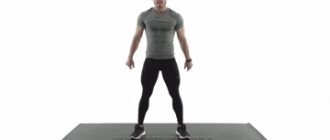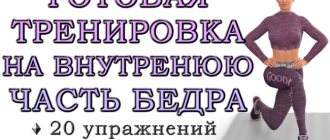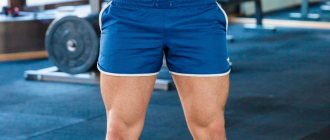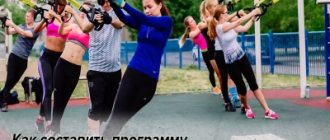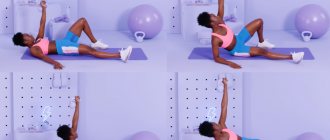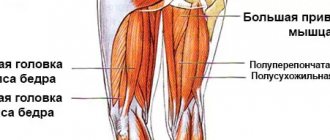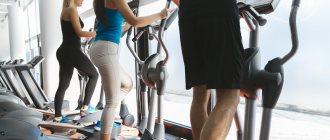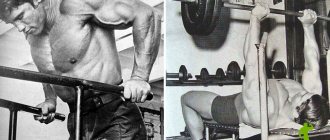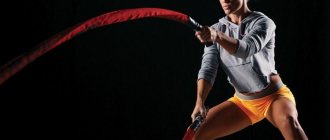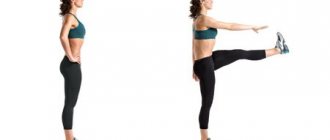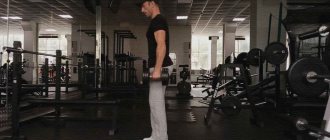© zamuruev — stock.adobe.com
Share:
What you need
- Barbell
- Dumbbells
- Exercise equipment
The leg muscles are the largest in the human body. Quadriceps exercises are performed by representatives of almost all sports disciplines. Without these exercises, you cannot achieve strength, mass, or endurance in your legs and body as a whole. The article discusses the best basic and isolated movements for the quadriceps for men and women, and presents training programs for boys and girls.
Anatomy of the quadriceps
The quadriceps (quadriceps femoris muscle) includes four muscle bundles:
- the vastus lateralis muscle is the largest bundle, participating in all movements associated with extension of the knee, and forming the lateral region of the thigh;
- vastus medialis (“droplet”) – also involved in movements associated with extension of the knee joint and is responsible for the formation of a rounded, full frontal surface of the knee;
- vastus intermedius muscle - located between the two previous bundles, actively involved in the work during extensions, squats, jumping, running;
- The rectus muscle is the longest bundle that gives the thigh a rounded shape, it is used not only in extension, but also in flexion, the only area of the quadriceps that is not directly attached to the femur.
© HANK GREBE - stock.adobe.com
To one degree or another, all areas of the muscle group in question are involved in the exercises described below. The quadriceps is responsible for the stability of the body in an upright position, ensures the movement of the lower leg in the knee joint, promotes tilting of the pelvis and pulling the legs towards the stomach.
How to strengthen the thigh muscles: effective ways and means
Strengthening of muscle fibers occurs only during exercise, such as sports training with weights or running exercises.
The main aspect is the correctness of the selected exercises and the optimal load. Effective exercises to strengthen your hips at home:
- Performing wall squats. Personal trainers recommend doing this type of exercise at home, as it will strengthen the muscles of the upper thighs and does not require additional sports equipment. Execution time is 10 minutes during the day, can be divided into several time periods of 5 minutes. The legs are at a distance of 50 cm from the wall, the back and head rest against the wall, the gluteal muscles are pressed to the back. Attention - the knees should not be in a flattened state, keep a right angle. We strain the muscles of the buttocks and back and hold the squat for half a minute. Straighten up and repeat the exercise.
- Simple squats. It is highly effective and simple, ideal for beginners. Squats will prepare a person for wall exercises. No additional sports elements are required. Execution: position your feet shoulder-width apart, straight back throughout the entire exercise, gradually lower your torso until your knees form an angle of 90 degrees. Professional athletes keep the muscles of the thighs and buttocks in constant tension; the knees should not extend beyond the toes, in which case the load will be distributed not on the muscles, but on the joints. Hold the bent position for half a minute. We return to the original straight position.
- Lunges forward. Lunges help maintain tone. Execution - feet shoulder-width apart, hands can be clasped in front of the chest or placed on the hips. The first step is taken with the right foot forward, the second step with the left foot forward. When stepping, the leg should be exactly parallel to the floor, the knee should not protrude beyond the toe. To determine whether the exercise is performed correctly, analyze the areas of muscle tension; a burning sensation should be felt in the gluteal muscles and along the front surface of the thigh, emphasis on the toe. Hold the lunge for about 15 seconds, then change legs. The minimum number of times per leg is 10. As the thigh muscles become prepared, the number of repetitions increases to 35.
- Circular movements of the leg. A simple exercise that is suitable for poorly trained people, the elderly and people with illnesses. Beginning of execution - we take a position lying on our back, the body is relaxed, the arms are lowered along the body, the palms rest on the floor. The right leg is raised 90 degrees, the toe is pulled up, the heel is directed inward. We strain our leg and slowly draw a circle of small radius. While drawing the circle, the leg is straight, the toe is pulled, the hips are motionless, the thigh muscles and the inner surface are involved. The minimum number of executions is 7, 3 approaches with each leg. For trained athletes, this exercise becomes more complicated - a weight is attached to the leg, the weight depends on the fitness of the muscles. For a comfortable performance, place a sports mat or other soft fabric under your back.
- Ladder. The exercise is suitable for performing at home; a staircase 5-7 steps long is suitable for starting lifting. We begin to climb the stairs sideways, alternately rearranging our legs in a cross, one side - one flight of stairs. The muscles of the inner thigh are involved. The exercise must be performed at a slow pace, quantity - 5 on each side.
- Lateral leg raises. Before starting class, place a mat under your back. We take a position lying on our side, our elbow rests on the floor, our hand supports our head. The pose should be relaxed and comfortable, the leg is raised at an angle of 50 degrees, the angle may have a smaller diameter if the stretch does not allow the exercise. Trainers say that to support and strengthen the hip muscles, lift slowly while inhaling, and lower while exhaling. The minimum number of repetitions is 8 times, 3 sets with each leg. To increase the load, it is recommended to use leg weights.
- Running exercises. Professional athletes say that the best exercise to strengthen the thigh muscles is running at varying intensities, such as jogging or interval running. Running training has a long-lasting effect and quick results. For fat burning, running workouts with varying speeds and the presence of obstacles, such as uphills or downhills, are recommended.
Features of working with quadriceps
Correct technique plays a huge role in the work of the quadriceps. The health and condition of the knees and lower back depends on it. By sinning with the technique of performing exercises, the athlete transfers the main load to other muscle groups.
Like all large muscles, the quadriceps muscle takes a long time to recover. In most cases, there is no point in training it more than once a week . An option with two leg workouts is allowed, but then they are separated: the first one works the quadriceps, the second one works the back of the thigh.
The basis of the training program should be basic (multi-joint) exercises. They are designed for mass and strength, as they load the legs and body in a complex manner. Isolated movements help to detail the muscles, give them a “cut,” and can also be used to warm up before heavy compound exercises.
For this reason, in the first few years of systematic training, you need to focus on the “base”. And only then, having gained mass and strength, you can start polishing your legs. This doesn't mean that beginners should ignore single-joint movements. They are also needed, but priority is given to the basic ones. This also applies to women seeking to lose weight and have a striking silhouette. Basic movements performed in a high-repetition style are the main secret to success.
Lying knee bend
Lying on your stomach, legs straight. Bend the knee of the leg you are working on, trying to touch your buttock with your heel. Hold for 5 seconds, then relax and return your leg to the starting position. 2 sets of 15 reps.
Strengthening exercises
You can start doing strengthening exercises only when the pain when walking up the stairs has completely gone away. Usually this is 1 week after the start of rehabilitation.
Quadriceps exercises
There are hundreds of leg exercises. There is no point in listing everything: those described in the article are more than enough. Moreover, most movements are variations of the basic ones.
Basic
This section describes the main exercises for the quadriceps. Beginners often try to stay away from them, but without a “base” they are nowhere.
Squats
The main and most “scary” exercise for beginners. Barbell squats work most of the muscles in the body—the legs, buttocks, back, and abs. Even the arms and shoulders can be used - without strong ligaments in the arms it is difficult to hold a heavy barbell.
At the very beginning, focus on execution technique. Squatting incorrectly can cause problems with your knees, lower back and neck. To put more stress on the quadriceps, train with relatively light weights. By going too far with the plates, the athlete will not be able to avoid the powerful engagement of the buttocks and back.
Squat pattern:
- Starting position (IP) – the bar lies on the trapezius (in no case on the neck), hands hold the bar with a narrow grip (as far as flexibility allows), chest forward, back straight. It is strictly forbidden to hunch over during the entire movement. Feet stand shoulder-width apart, toes slightly pointed to the sides. To get into IP, you need to sit under the bar lying on the racks, remove it and step back.
- You need to start a squat by moving your pelvis back. The knees are in line with the feet - you cannot turn your knees inward. Also try not to bring them forward with your feet.
- Lower yourself to a position where your thighs are parallel to the floor. By undersquatting, you don't do enough work; by squatting deeper, you take the load off your quadriceps and put more stress on your gluteal muscles.
- Smoothly but powerfully, as you exhale, return to IP. The knees should remain slightly bent at the top - this is a prerequisite for reducing the risk of injury from the exercise.
The position of the legs can and should be varied - from narrow to a position slightly wider than the shoulders. If the position is too wide, the biceps of the thigh are more loaded. When squatting, your feet do not leave the floor. When performing the movement, look in front of you or slightly up. This helps keep your back straight and focused on the exercise.
At home, the barbell can be replaced with dumbbells. In this case, the hands with the shells are lowered down.
Front squats with barbell
Front squats are a similar exercise in which the barbell is placed in front rather than behind. Thanks to this, the load on the quadriceps becomes more targeted - the buttocks are used much less.
Technique:
- Approach the bar lying on the racks and fix it on the front delts. The hands are placed crosswise, helping to hold the barbell - this is IP.
- Keeping your back absolutely straight, squat down to parallel.
- Return to IP.
© Makatserchyk — stock.adobe.com
In this exercise, keeping your back straight is more difficult, so you need to not overdo it with the weight of the projectile.
The position of the hands may be different. Trained lifters often secure the bar with their hands positioned in the style of a weightlifter performing a clean and jerk. To do this you need to have a certain flexibility, strong ligaments and a powerful grip.
Leg press
The leg press eliminates the work of the back and buttocks as much as possible. At the same time, the simulator makes it possible to work with much more weight than in squats. To place the load on the quadriceps, you need to press with your feet shoulder-width apart.
Technique:
- IP - the back and head are tightly pressed to the back of the simulator, the legs are almost completely straightened and rest against the bed, the hands firmly hold the handles.
- Bend your knees until a right angle is formed between your thighs and shins.
- Return your legs to IP.
At the top point, the knees must be slightly bent. This is especially important with leg presses, since full extension can result in very serious injury.
A variation of this exercise is the single leg press. In this case, the weight is taken significantly less.
© bennymarty — stock.adobe.com
Hack squats
Since the back in this exercise is also pressed tightly against the back of the machine, the main load is placed on the quadriceps muscles of the legs. The exercise is an inverted press - it is not the feet that go up, but the body.
Execution scheme:
- IP - standing on the platform, feet positioned shoulder-width apart, body straight, shoulders resting on the pillows, hands holding the handles.
- Lower yourself down to parallel, feeling the tension in your quadriceps.
- Return to IP.
© splitov27 — stock.adobe.com
You cannot round your back, lift your toes or heels off the platform, and completely straighten your knees at the top.
Lunges with barbell and dumbbells
Lunges can be done in different ways - with a barbell, in a Smith machine, with dumbbells, walking around the gym and standing still. Let's consider options in which the athlete stands in one place, using either a barbell or dumbbells.
Technique for working with the bar:
- The IP is similar to the position for back squats.
- Step forward with your right foot. The lunge should be such that the thigh of the working leg at the lowest point is parallel to the floor. The knee of the left leg almost touches the floor and also forms a right angle.
- Return to IP.
- Switch legs and lunge with your left leg.
© Makatserchyk — stock.adobe.com
Do the same exercise with dumbbells. In this case, the hands with the projectiles are lowered along the body:
© Makatserchyk — stock.adobe.com
The disadvantage of this option is that it does not always allow you to work with a suitable weight. The grip is weaker than the legs, so training with a barbell is preferable. But for women who carry light weights, dumbbells are a good option. Men who use wrist straps or have a strong grip will also appreciate this option.
Single leg squats
Can't go to the gym? Squat on one leg. This is a great quadriceps exercise that can work your legs without even using additional weights. True, you shouldn’t expect a significant increase in mass or strength from him.
Scheme:
- IP – standing, “non-working” leg slightly extended forward.
- Squat down to parallel, extending your other leg so as to form a “pistol” (another name for this exercise).
- Return to IP.
© Makatserchyk — stock.adobe.com
Unlike regular squats, this variation does not require keeping your back straight. A slight rounding is normal. It is important to stand up using the force of the quadriceps, minimizing the involvement of the buttocks.
Isolated exercises
These movements will not make the legs more massive, but they will bring to mind what has been developed as a “base”.
Leg extensions in the simulator
This exercise draws out the front of the thigh. Suitable for warming up before a heavy squat (15-20 repetitions with a light weight without failure), and for “finishing up” at the end of a leg workout.
Technique:
- IP - sitting in the simulator, the lower back is pressed against the back, the legs are bent at the knees, the feet are fixed with bolsters, the hands hold the handles tightly.
- Straighten your legs at the knee joints.
- Pause for a moment at the top, tensing your quadriceps as much as possible, then return your legs to the IP position.
© Makatserchyk — stock.adobe.com
Do the exercise until your muscles burn. The movements are smooth and slow; if you are negative, you should not “throw” your legs down, lower them under control.
Training complex
1. The first and main basic exercise will be the squat with a barbell. Starting position: feet shoulder-width apart, toes parallel to each other. You should squat to an angle of 90 degrees. The main role is played by technique, watch your back, remember that it should always be in a level position. You can shift the center of the load slightly to the inner thighs by placing your feet slightly wider than shoulder-width apart, while pointing your toes out from the center.
Do not take too much weight, your quadriceps may not withstand the load and this is fraught with at least poor technique, in the form of bending your back. Otherwise, you may end up squatting and not getting up because the weight is too much for you to handle. Therefore, you need to treat this exercise with great responsibility and select the working weight individually. Girls can do squats on a Smith machine. This is a lightweight alternative that will increase the level of safety, however, the load will be no weaker than a regular squat.
2. The second, quite effective exercise is squatting in a hack machine. This type of squat is considered the best version that can replace classic squats. The big advantage is that the lower back and back are supported in the form of the back of the exercise machine, thereby receiving minimal load, while the quadriceps will be loaded to the maximum.
3. Leg press. The main load goes to the hamstrings, however, if you place your feet close to each other, you can shift the center of the load to the quadriceps muscle. To increase the intensity of pumping, place your feet on the lower edge of the platform; when doing this, try not to fully straighten your knees, this has a negative impact on the knee joint and also reduces the load.
4. Lunges for the gluteal muscles and quadriceps. Can be performed both in the gym and at home. You will need two dumbbells. Stand in front of the mirror and take a long step forward with dumbbells, while your back should be in a straight position, the knee of the knee that drops out touches the floor. A more complex variety will be lunges, which are done without touching the knee to the floor.
In this case, you will always keep your muscles tense, this will give maximum results. To maintain balance, you need to place your feet shoulder-width apart; during a lunge, the back leg remains motionless. An excellent exercise for women who would like to tighten their butt and give their buttocks a beautiful shape.
5. Leg extensions. While sitting in the exercise machine, you should lift a block with weights with your feet and linger at the top point. An isolated exercise will give maximum results when the angle between your legs and back is 90 degrees.
Dear friends, we have looked at the most effective exercises for quadriceps, now I would like to share with you a couple of secrets that would help improve the result.
